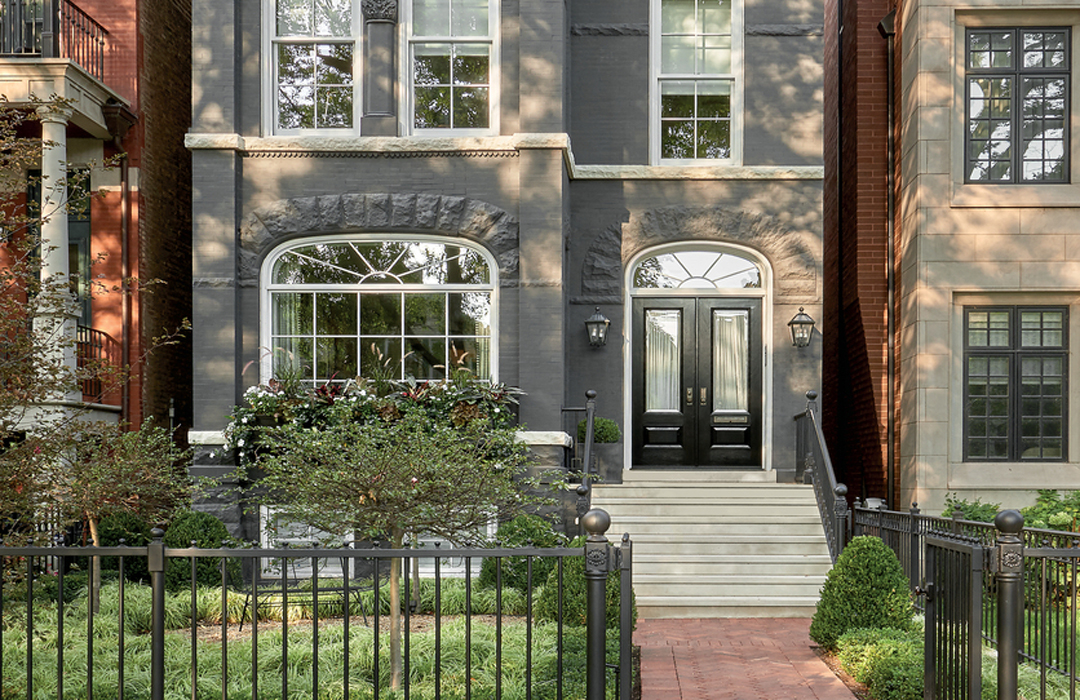
Designer Jessica Supera has a passion for historic homes. “I love them,” she says. “But they get torn down all over Chicago.” So when a three-unit 1886 building in Lincoln Park became available, she jumped at the chance to make it a home for her, her three children and the family dog. Together with architect Seth Romig and builder Jeff Berry, she transformed it into a single-family residence, drawing inspiration from the layouts of Brooklyn brownstones. “We took it apart and put it back together in the way I’d imagine a home would’ve been,” Supera says.
Everything changed during the gut renovation. “We kept the front and side walls and rebuilt everything on the interiors,” Romig says. “Rather than tear down, we could repurpose for contemporary use.” The facade saw a restoration and a new masonry stain. The layout–mostly true to a Brooklyn brownstone–positions a vestibule at the entry, a front parlor (which serves as Supera’s office), a dining room and, at the rear, a family room and the kitchen. The two upper levels each contain two bedrooms, while the lower level, which opens to an outdoor space, holds a large entertainment area, a guest room, a craft room and a kitchenette.
Supera wanted exterior spaces on all public levels, so each has an outdoor area connected by an exterior stair. Landscape designer Denise Rosenbloom set out to create “a contemporary twist to match Jessica’s style while sustaining a welcoming old-world feel,” she explains. The look comes together through elements such as a large window box at the front, fluffy Carex grass instead of sod and exterior wall art with ferns, ivy and leaves.
Access to light was also a main consideration, because the building is in the middle of a block on a standard 25-by-125-foot lot. Windows in the front parlor are grand in scale, as are the ones in the kitchen, where the patio door is paned in glass. A 20-foot skylight on the third level casts light over the upper floors and the stair designed by Romig. “I’m a fan of architectural moments of serenity and peacefulness in connection to the exterior, especially nature,” he says. As such, coming through the front door, guests see light trickling down the stairs as well as from the parlor, the entrances to other rooms and the kitchen. “The house unfolds with rhythm, connection and interest,” the architect says.
As for the interiors, Supera maintained a focused perspective on what she was looking for–and her philosophy on design in general. “I think homes should be somewhat malleable,” she says. “The underlying base layer should have texture and be interesting, but the palette should be neutral.”
The “base layer” approach, as she calls it, is smart and subtle: white walls and trim; white-oak floors throughout, except for some areas tiled in a white-gray-black pattern; and a pale wood kitchen, designed by Peter Harris of O’Brien Harris. “Blonde is back,” Berry says. “Recently, the design community is going toward more natural blonde boards, so we gave these a clear finish.”
Black accents appear as metal drapery hardware, metal lighting arms, the fireplace opening in the front parlor, tabletop accessories and the occasional furniture frame, like the master’s wood four-poster and the dining chairs’ metal frames, which support a light-oak form with a natural-rattan caned back.
Throughout the residence, texture brings depth to neutral furnishings–particularly in the master bedroom, where a woven rug pulls together a seating area underneath a rope chandelier. Together with the caned headboard and woven blinds, they create a unified sense of warmth. “There’s very little color, but everything has a texture to it,” Supera points out. “It’s very peaceful.”
The designer’s taste for furnishings is eclectic, with a mix of old and new, vintage and modern in each room. But they, too, adhere to a clean-lined scheme. “I like things that are graphic, sculptural and well-designed,” Supera says. The result is a look that’s more curated than designed. “I didn’t go from showroom to showroom,” she says. “I purchased items in London and in Paris, I went to California, and I brought some pieces from my last house. It’s more of a food-truck philosophy.”
But that doesn’t mean Supera’s home is done, per se. “I don’t believe in finishing every space,” she says. “I have empty walls and corners. You don’t need to cover every surface for your house to look finished. You should have room for the next chapter in your life.”
HOUSE DETAILS
- Style:Contemporary
- Photography:Tony Soluri
- Interior Design:Jessica Supera, S.O.F.T. Homes
- Architecture:Seth Romig, Seth Romig Architect
- Home Builder:Jeff Berry, Goldberg General Contracting, Inc.
- Landscape Architecture:Denise Rosenbloom, Botanical Concepts Chicago

